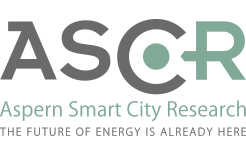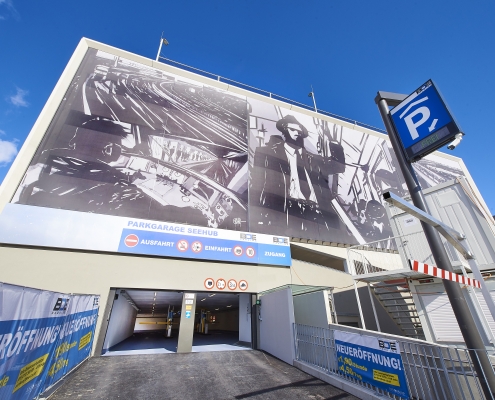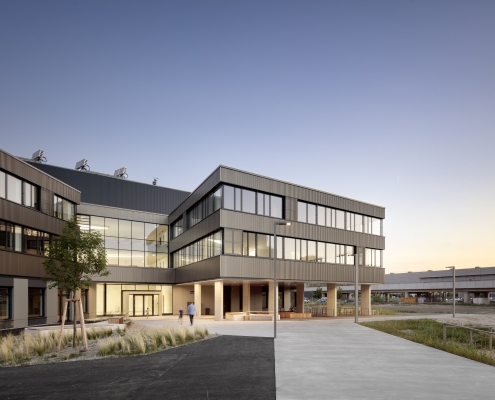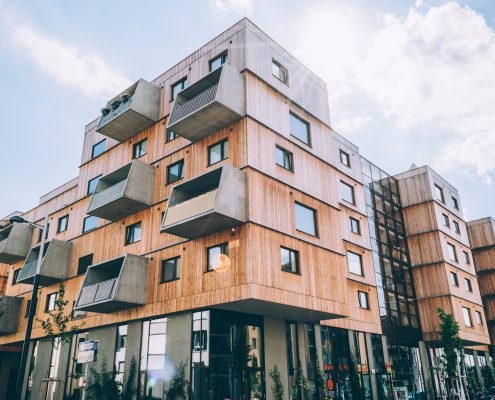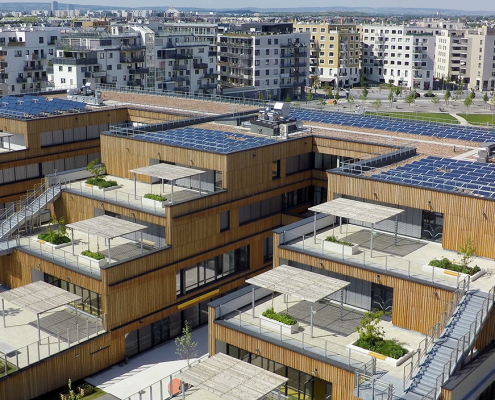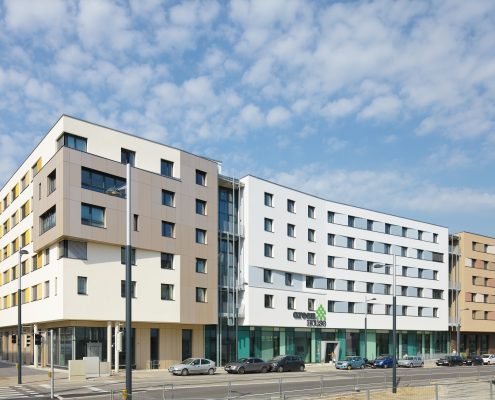In Europe, buildings account for 40% of final energy consumption. This translates into a correspondingly high potential for a climate-friendly energy future. Within the “Smart Building” domain, ASCR is therefore exploring the role of buildings as producers of renewable energy, identifying potential savings while maintaining a high level of comfort for residents, and the lowest possible construction and maintenance costs over the entire life cycle of the building.
The specific research environments involved are five buildings in aspern Seestadt, each of which has a different use: a residential building, a student hall of residence, an integrated school and daycare centre, a technology centre as a modern workplace environment, and an additional office building with sports facilities and indoor parking. In the course of the current research phase, the project will focus on smart charging for e-cars.
ASCR deliberately selected the buildings and facilities to ensure that a wide range of requirements can be observed in a cost-efficient manner and that answers can be found to as many questions as possible. The buildings were equipped with state-of-the-art technology: photovoltaics, solar thermal energy, hybrid systems, heat pumps and thermal and electrical storage units.
Smart buildings communicating with each other
From photovoltaic systems and heat pumps to individual households and storage media – the buildings of the future will be equipped with a wide variety of sensors. ASCR is researching how to interconnect these sensors and use them from one central location with the aim of optimising internal consumption. The core element in this process is the intelligent building energy management system (BEMS). It interlinks all the measured data and reacts automatically to any changes. In the next step, it learns to “speak” with the sensors and actuators of other buildings.
The BEMS is able to predict the energy requirements and expected energy production of the buildings by incorporating information on use habits, sensor data and weather forecasts. In this way, smart buildings not only facilitate intelligent energy consumption, but also enable energy to be produced, stored for later use if required, or fed into the grid.
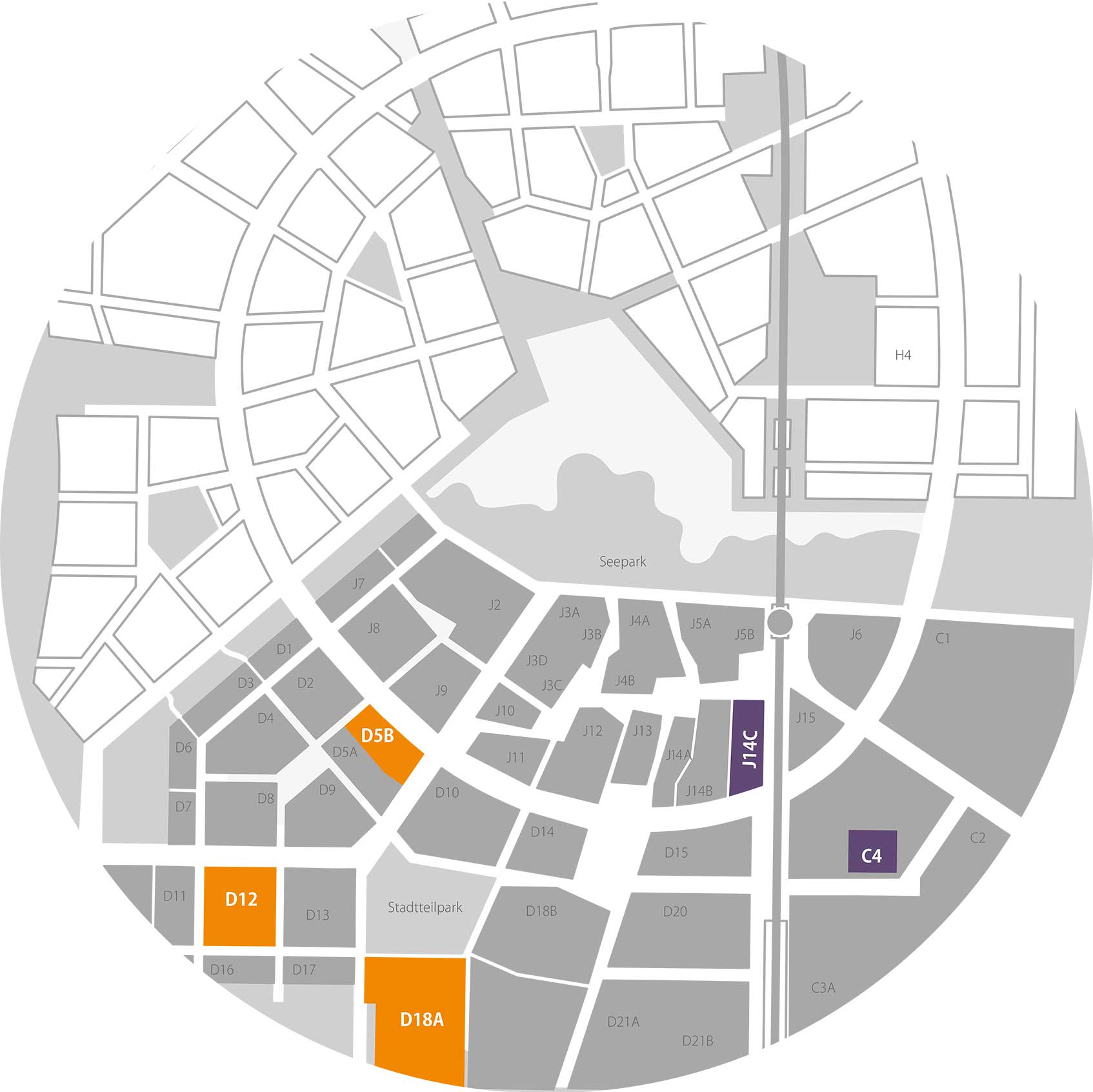
D5B Student hall of residence
- Electricity storage system (150 kWh available)
- Central warm water reservoir & e-cartridges (2 x 8 kW, continuously variable)
- Smart MSR
- Photovoltaics (PV Peak: 221 kW)
D12 Residential buildings
- Hight-temperature water reservoir (6 x 2000 l)
- Thermal underground storage tank (approx. 6.000 m³ or 40.000 kWh)
- Electricity storage system (2 kWh)
- Home Automation (111 households)
- Smart MSR
- Solar thermal energy (90 kW)
- Photovoltaics (PV Peak: 15 kW)
- Hybrid (Peak: 20 kW electrical + 60 kW thermal)
- Various heat pumps (approx. 700 kW thermal)
D18A Educational campus
- Central warm water reservoir & e-cartridges (70 kW, step-wise variable)
- Smart MSR
- Solar thermal energy (90 kW)
- Photovoltaics (PV Peak: 58 kW)
- 2 heat pumps (510 kW thermal)
J14C SeeHUB List Garage
- Combi heat pump/cooling unit (370kW thermal, groundwater)
- Heating of drinking water (central HT rail, offices with de-centralized electric TWE)
- Room heating (NT rails with convectors)
- Room cooling (cold rails with cold water fan coils)
- Central venitlation system
- Photovoltaics (PV Peak: 15kW)
- E-mobility (with several E-charging points)
- BAT system (stationary 180kWh, >100kW)
- Photovoltaics (PV Peak: 15kW)
- Allocation (dynamic power supply capacity allocation according to availability)
C4 Technologiezentrum
Seestadt Bauteil 2 & 3
- Combi heat pump/cooling unit (250kW thermal, exhaust air from building, groundwater)
- Room heating (only NT rails with ceiling-activation of the concrete core)
- Heating of drinking water (decentralized and electric, also showers with electric flow heaters)
- Room cooling (cold rails over concrete ceiling)
- Central ventilation system (full air conditioning including dehumidification)
- Photovoltaics (PV Peak 60kW)
- Photovoltaics (PV Peak 2x40kW, communal system for commerical tenants with dynamic allocation of PV generation)
Communal electricity production in energy districts
Enabling the automated, optimally controlled use, storage and transmission of energy – not only in individual buildings, but extending to entire communities – is a new challenge. Buildings can be organised in “energy districts” to exchange information and supply each other with energy.
To optimally exploit this enormous potential for ensuring energy supply security for urban populations, the buildings must be integrated into an overall market and grid concept. We need systems that collect and coordinate these smaller flexibilities in a virtual power plant so that they can participate in balancing energy markets. This is achieved via the DEM system. It facilitates a constant exchange of information between buildings, the market and the transmission system operator. The transmission system operator, in our case the APG, can activate control energy as needed (i.e. to balance out deviations in the grid voltage or frequency). This command automatically triggers changes in the current operation of the systems in our buildings. The buildings can then trade their flexibilities on the control energy market.
Digital twin technology for full transparency
Another ASCR research area is the use of digital building twins, both during the planning and construction phase and during operation. Building information modelling (BIM) offers great potential for efficiency, novel construction methods and facility management. Information about the current status of individual building units can be provided on an ongoing basis, and BIM also enables forward-looking and cost-efficient planning and maintenance.
Smart Building
- UC5a Heat pump systems and fedding into the district heating network
- UC5b Underfloor cooling
- UC5d Building-integrated photovoltaics / tennant electricity model
- UC5e Human centric lighting
- UC8 Renewable energy communities
- UC11 Smart charging
- UC12 Optimized Energy demand within buildings
- UC14 Smart Maintenance
- UC15 Digital Building Twin
The smart buildings in aspern Seestadt are already interacting with balancing energy markets. Thanks to an extensive range of empirical data, sensors, and access to weather data, they know in advance how much excess electricity can be produced, stored or profitably sold on the electricity market.
This provision of control energy was successfully tested in the student hall of residence. Using virtual power plants, a combination of multiple photovoltaic systems and batteries, it will be possible to make a significant contribution to the energy revolution and, in particular, to securing the city’s energy supply. Extrapolation of the latest interim results yields the following projection: if 20 percent of Vienna’s buildings are fitted with the technology tested here, a profit of 30 million euros per year can be generated for the city and its residents.
ASCR was able to achieve a number of positive results in increasing efficiency. Thanks to innovative energy systems consisting of renewable generation plants and various storage technologies operated by an intelligent control system, smart residential buildings save more than 71% or almost 240t of CO2 emissions per year as compared to conventional gas boiler heating systems. Introducing a purely green electricity tariff would further increase the savings potential.
By using a ground storage unit, solar thermal systems can generate significantly higher yields than systems that are only equipped with hot water storage units. Nocturnal heat requirements in residential buildings can also be adequately covered by overloading the thermal storage units, especially during transitional periods. This reduces heat pump operating hours, which translates into cost and energy savings.
Waste heat recovery in the school and daycare centre saves 195 MWh/year, which represents annual financial savings of about 10,000 euros. The air source heat pump in the parking garage exhaust air system in residential buildings uses the garage exhaust air as an additional heat source.
The battery storage unit in the hall of residence reduces peak loads on the mains supply, thus saving up to 5,000 euros per year.
